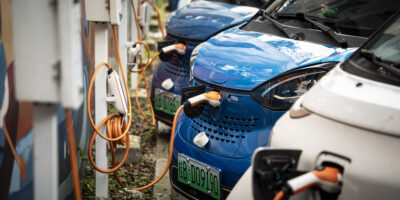
Richard Liu, founder and current CEO of JD.com, has once again evolved the shopping experience for billions of loyal customers by opening two brand new “offline experience” stores in high-traffic hubs. The successful opening of these two innovative shopping ventures further propels JD.com’s model of Boundaryless Retail. However, it’s not an entirely new venture for Liu. Roughly two decades ago, Liu opened his first retail location, selling magneto-optical goods in a tech-heavy area of Beijing. Through unparalleled customer service and the sale of authenticated product, Liu was able to quickly expand his retail venture to include over a dozen brick-and-mortar storefronts.
China’s 2002 SARS epidemic, however, changed the trajectory of the business as a whole, and Liu made the bold choice to move his wares online when e-commerce was still somewhat unchartered territory. From there, the company has grown into a world renowned juggernaut, has become the first China-based company to be traded on NASDAQ, employs the largest fleet of drones for delivery, and enjoys partnerships with global leaders such as Walmart and Google. Throughout this vast expanse of growth, innovation, and technological advancement, JD.com has continued to grow its business model, focusing on a streamlined model that allows shoppers to easily garner desired goods at any time, through various means, and at any location.
With recent forays into fresh food delivery, fresh food markets, partnerships with hotel chains, and even unmanned convenience stores that operate solely on “smart store technology,” a venture into the retail space appears to be a natural progression toward continued brand recognizability and JD’s Boundaryless Retail model. The two new retail shopping ventures, located in Beijing Capital International Airport and Inner Mongolia’s Hohhot East Railway Station, aim to parlay perfected AI technology, big data, and robotics to create a tailored and thoroughly modern shopping experience for busy travelers.
The pop-up location within the departure lounge at the BCIA’s Terminal 3 offers customers various travel aides, daily necessities, tech accessories, luggage, and other useful travel companions in a streamline, direct manner. This model focuses on two JD.com staples: high-quality product and unparalleled ease from start to finish. As with JD’s other “smart store” ventures, this pop-up location utilizes various AI features to create a successful shopping experience. Cameras capture customer movement, interest in product, and general traffic flow, all of which provides invaluable information to the retailer. With concise insights regarding product trends based on these customer interactions, the company can stock this location in the most effective manner and ensure that the space is adequately utilized for maximum customer satisfaction. In addition to assisting with product selection, the utilization of the JD Zu Chongzhi platform allows for seamless inventory control and makes back-end management of each retail space a straightforward task.
At the Hohhot East Railway Station, JD.com has partnered with China Railway Express to open a 100-square-meter unmanned convenience store location, much like the unmanned model previously tested at the company’s Beijing headquarters. This location aims to provide busy travelers with on-the-go essentials, snacks, and other wares. Though the concept is similar to a traditional convenience store, JD leverages smart technology for a truly personalized shopping experience. Through the use of facial recognition payment, customers are able to peruse product and complete the checkout process without having to stop. Additionally, the smart vending machines process payment automatically once a customer selects a product and closes the “vending door,” allowing for a grab-and-go selection that is seamlessly paid for without the need for a traditional POS counter.
For consumers thinking ahead, JD plans to integrate a WeChat technology in the near future that will allow customers to choose between purchasing a product to carry out and ordering said product for delivery to a certain location. This technology will utilize Liu’s already perfected drone delivery system, which is capable of reaching a population of over one billion people, even in the most remote areas. Not only does this aid the quick-service customer, but it also allows customers to place an order for a future date, a convenient tool for those who tend to remember their shopping needs on a visual scale.
With so many individuals traveling extensively, an increasingly large number of people utilize the time to shop for everyday essentials, as well as last-minute travel necessities not previously considered. From the morning commuter who orders a grocery delivery before arriving at work to the business executive who never remembers noise cancelling headphones before takeoff, the relationship between travel and shopping is an ever-present one, a fact not lost on Liu and the team at JD. According to Bing Zhang, the company’s General Manager of Social E-Commerce and Retail Innovation, “many of [JD’s] customers enjoy shopping while traveling, and [the company is] determined to make sure they benefit from the convenience of JD wherever they are.”
While Liu’s business savvy, forward thinking, and ingenuity have allowed JD.com to rise to the top of the proverbial e-commerce mountain, the integration of physical retail spaces feels like a fresh take on growth. As JD’s Boundaryless Retail mission continues to strive for seamless shopping through any capacity, the physical immersion of daily lives with JD-powered shopping experiences provides yet another opportunity to achieve this goal.
Perhaps debunking the now-standard model of e-commerce-driven companies, more and more initially internet-based companies are choosing to enter the physical retail space. However, with the utilization of “smart technology,” Big Data, and AI, these new retail spaces are anything but standard big box retailers. With customized promotions for “signed in” customers, unmanned checkout options, virtually automated stocking and inventory management, and even facial recognition technology, the utilization of technology for the benefit of consumers and business owners alike sets these spaces apart.
For Liu, continuously scaling JD.com means investing in the technology that will drive his company forward and testing the boundaries when it comes to shopping experiences. With the end-game goal of being considered a one-stop-shop for all types of shopping needs, the grand opening of the two new tech-driven spaces showcases the company’s continued commitment to its mission statement.
For more read: https://jdcorporateblog.com/jd-offline-experience-stores-put-high-tech-retail-on-the-schedule-for-travelers/


